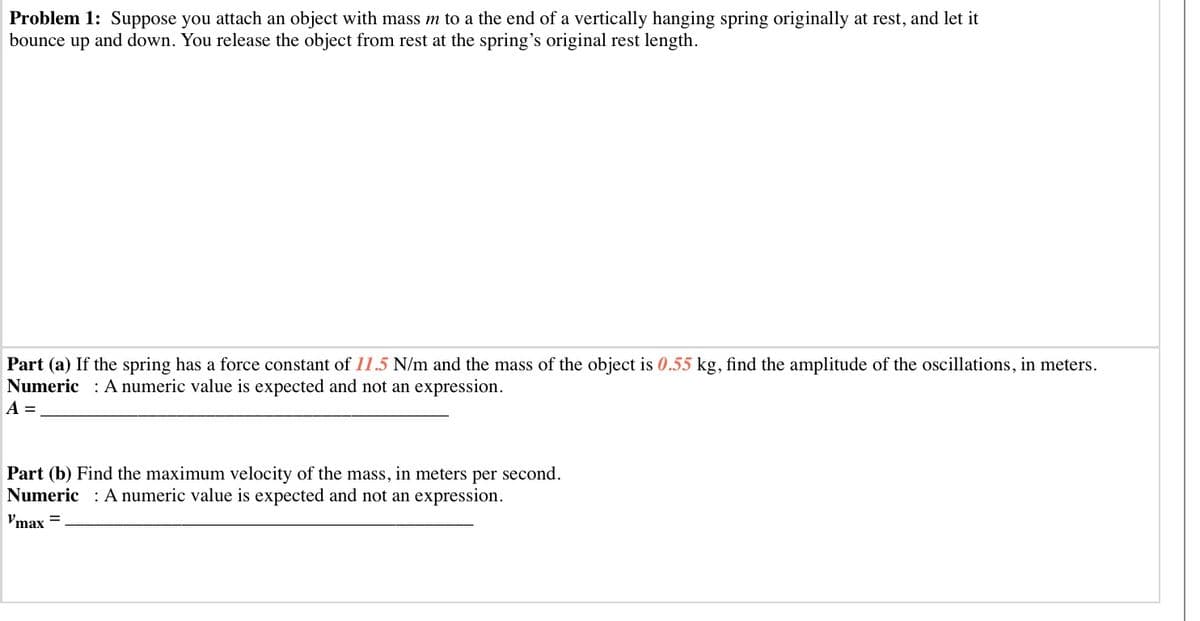Problem 1: Suppose you attach an object with mass m to a the end of a vertically hanging spring originally at rest, and let it bounce up and down. You release the object from rest at the spring's original rest length. Part (a) If the spring has a force constant of 11.5 N/m and the mass of the object is 0.55 kg, find the amplitude of the oscillations, in meters. Numeric : Anumeric value is expected and not an expression. A = Part (b) Find the maximum velocity of the mass, in meters per second. Numeric : A numeric value is expected and not an expression. 'max =
Problem 1: Suppose you attach an object with mass m to a the end of a vertically hanging spring originally at rest, and let it bounce up and down. You release the object from rest at the spring's original rest length. Part (a) If the spring has a force constant of 11.5 N/m and the mass of the object is 0.55 kg, find the amplitude of the oscillations, in meters. Numeric : Anumeric value is expected and not an expression. A = Part (b) Find the maximum velocity of the mass, in meters per second. Numeric : A numeric value is expected and not an expression. 'max =
Physics for Scientists and Engineers: Foundations and Connections
1st Edition
ISBN:9781133939146
Author:Katz, Debora M.
Publisher:Katz, Debora M.
Chapter2: One Dimensional Motion
Section: Chapter Questions
Problem 18PQ
Related questions
Question
10.1

Transcribed Image Text:Problem 1: Suppose you attach an object with mass m to a the end of a vertically hanging spring originally at rest, and let it
bounce up and down. You release the object from rest at the spring's original rest length.
Part (a) If the spring has a force constant of 11.5 N/m and the mass of the object is 0.55 kg, find the amplitude of the oscillations, in meters.
Numeric : A numeric value is expected and not an expression.
A =
Part (b) Find the maximum velocity of the mass, in meters per second.
Numeric : A numeric value is expected and not an expression.
Vmax =
Expert Solution
This question has been solved!
Explore an expertly crafted, step-by-step solution for a thorough understanding of key concepts.
This is a popular solution!
Trending now
This is a popular solution!
Step by step
Solved in 2 steps

Knowledge Booster
Learn more about
Need a deep-dive on the concept behind this application? Look no further. Learn more about this topic, physics and related others by exploring similar questions and additional content below.Recommended textbooks for you

Physics for Scientists and Engineers: Foundations…
Physics
ISBN:
9781133939146
Author:
Katz, Debora M.
Publisher:
Cengage Learning

Principles of Physics: A Calculus-Based Text
Physics
ISBN:
9781133104261
Author:
Raymond A. Serway, John W. Jewett
Publisher:
Cengage Learning

Classical Dynamics of Particles and Systems
Physics
ISBN:
9780534408961
Author:
Stephen T. Thornton, Jerry B. Marion
Publisher:
Cengage Learning

Physics for Scientists and Engineers: Foundations…
Physics
ISBN:
9781133939146
Author:
Katz, Debora M.
Publisher:
Cengage Learning

Principles of Physics: A Calculus-Based Text
Physics
ISBN:
9781133104261
Author:
Raymond A. Serway, John W. Jewett
Publisher:
Cengage Learning

Classical Dynamics of Particles and Systems
Physics
ISBN:
9780534408961
Author:
Stephen T. Thornton, Jerry B. Marion
Publisher:
Cengage Learning

Physics for Scientists and Engineers
Physics
ISBN:
9781337553278
Author:
Raymond A. Serway, John W. Jewett
Publisher:
Cengage Learning

Physics for Scientists and Engineers with Modern …
Physics
ISBN:
9781337553292
Author:
Raymond A. Serway, John W. Jewett
Publisher:
Cengage Learning

Modern Physics
Physics
ISBN:
9781111794378
Author:
Raymond A. Serway, Clement J. Moses, Curt A. Moyer
Publisher:
Cengage Learning